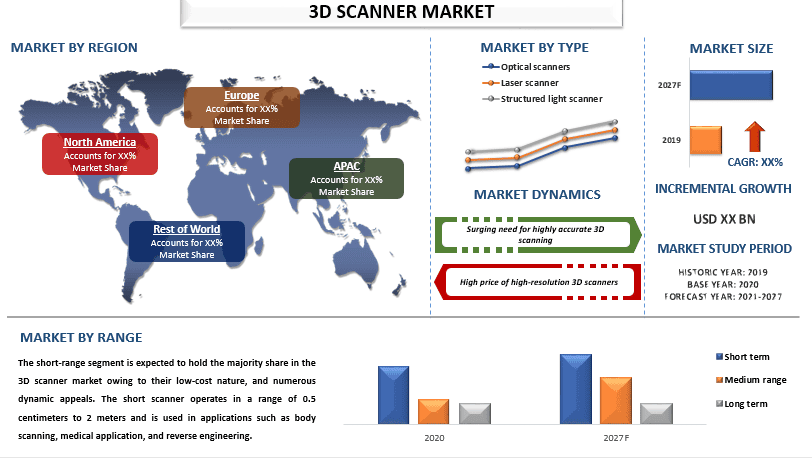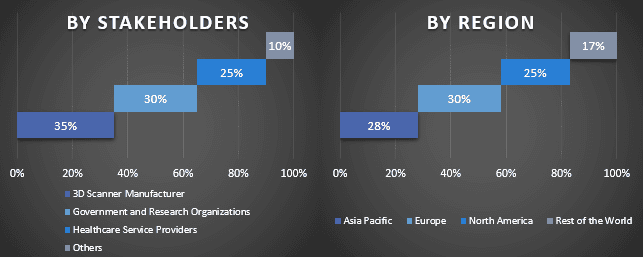Рынок 3D-сканеров: текущий анализ и прогноз (2021-2027)
Акцент на типе (оптический сканер, лазерный сканер, сканер структурированного света), диапазоне (малый диапазон, средний диапазон, большой диапазон); применение (развлечения и СМИ, аэрокосмическая промышленность и оборона, здравоохранение, гражданское строительство и архитектура, промышленное производство, прочее); регион/страны

Ожидается, что рынок 3D-сканеров будет расти со среднегодовым темпом роста 12% в течение прогнозируемого периода.Рынок обусловлен увеличением расходов на НИОКР и достижениями в технологиях. Кроме того, появление технологии структурированного света также, как ожидается, будет стимулировать рост рынка 3D-сканеров. В дополнение к этому, технология 3D-сканирования экономит время, деньги и трудозатраты, а также улучшает качество продукции в процессе производства. В основном, 3D-сканер использует лазер, свет или рентгеновские лучи для захвата размеров реального объекта и создания облака точек. Облака точек используются для создания 3D-моделей сканированных объектов с использованием программного обеспечения. Кроме того, технология сканирования 3D-принтера набирает популярность в аэрокосмической, военной, автомобильной, медицинской и других областях.
Представленные в отчете выводы
«Ожидается, что сегмент лазерных сканеров продемонстрирует самый высокий среднегодовой темп роста в течение прогнозируемого периода»
В зависимости от типа, рынок сегментирован на оптические сканеры, лазерные сканеры и сканеры структурированного света. Ожидается, что сегмент лазерных сканеров займет большую часть рынка 3D-сканеров благодаря своей способности захватывать миллионы точек данных за секунды. Эти сканеры используют лазерный свет для захвата физических данных в окружающей среде. Лазерные сканеры, как правило, идеально подходят для сканирования чувствительных сред и объектов.
«Ожидается, что сегмент малого диапазона продемонстрирует самый высокий среднегодовой темп роста в течение прогнозируемого периода»
В зависимости от диапазона, рынок сегментирован на малый диапазон, средний диапазон и большой диапазон. Ожидается, что сегмент малого диапазона займет большую часть рынка 3D-сканеров благодаря таким преимуществам, как низкая стоимость и многочисленные динамические привлекательности. Малый сканер работает в диапазоне от 0,5 сантиметра до 2 метров и используется в таких приложениях, как сканирование тела, медицинское применение и обратное проектирование.
«Ожидается, что сегмент оборудования продемонстрирует самый высокий среднегодовой темп роста в течение прогнозируемого периода»
В зависимости от предложения, рынок сегментирован на оборудование, программное обеспечение и услуги. Ожидается, что сегмент оборудования будет доминировать на рынке 3D-сканеров в течение прогнозируемого периода. Ожидается, что достижения и внедрение новых технологий 3D-сканирования будут стимулировать рынок в течение прогнозируемого периода.
«Ожидается, что сегмент здравоохранения продемонстрирует самый высокий среднегодовой темп роста в течение прогнозируемого периода»
В зависимости от области применения, рынок сегментирован на развлечения и СМИ, аэрокосмическую промышленность и оборону, здравоохранение, гражданское строительство и архитектуру, промышленное производство и другие. Ожидается, что сегмент здравоохранения займет большую часть рынка 3D-сканеров в течение прогнозируемого периода. Индивидуальное моделирование протезов с использованием 3D-сканирования и печати в секторе здравоохранения продолжает стимулировать рост 3D-технологий в динамичной индустрии медико-биологических наук. Технология 3D-сканирования используется для отображения расширенной 3D-модели человеческого тела, чтобы помочь в анатомии человеческого тела и отображать живую 3D-проекцию человеческого тела для помощи в манипуляциях.
«Ожидается, что Азиатско-Тихоокеанский регион продемонстрирует значительный рост в течение прогнозируемого периода»
Азиатско-Тихоокеанский регион занимает большую часть рынка 3D-сканирования благодаря присутствию основных игроков в регионе. Страны АТР участвуют в производстве оборонных самолетов, что приводит к увеличению спроса на 3D-сканеры для инспекционных приложений в аэрокосмической и оборонной промышленности региона. Растущее население, процветающая экономика (развитая и развивающаяся) и текущие правительственные инициативы по содействию промышленному росту сделали АТР идеальным местом для создания производственных подразделений различных отраслей, включая полупроводники, электронику и автомобилестроение. Ожидается, что спрос на автомобили в АТР вырастет в ближайшие годы. Это, в свою очередь, приведет к увеличению производства транспортных средств в регионе, тем самым способствуя спросу на 3D-сканеры.
Причины для покупки этого отчета:
- Исследование включает в себя определение размеров рынка и анализ прогнозирования, подтвержденные проверенными ключевыми экспертами отрасли.
- Отчет представляет собой краткий обзор общей производительности отрасли с первого взгляда.
- Отчет охватывает углубленный анализ выдающихся отраслевых коллег с основным акцентом на ключевые финансовые показатели бизнеса, портфели продуктов, стратегии расширения и недавние разработки.
- Детальное изучение движущих сил, ограничений, ключевых тенденций и возможностей, преобладающих в отрасли.
- Исследование всесторонне охватывает рынок по различным сегментам.
- Углубленный анализ отрасли на региональном уровне.
Варианты настройки:
Глобальный рынок 3D-сканеров может быть дополнительно настроен в соответствии с требованиями или любым другим сегментом рынка. Кроме того, UMI понимает, что у вас могут быть свои собственные бизнес-потребности, поэтому не стесняйтесь обращаться к нам, чтобы получить отчет, который полностью соответствует вашим требованиям.
Содержание
Анализ исторического рынка, оценка текущего рынка и прогнозирование будущего рынка глобального рынка 3D-сканеров были тремя основными шагами, предпринятыми для создания и анализа внедрения 3D-сканеров в основных регионах мира. Был проведен исчерпывающий вторичный анализ для сбора исторических данных о рынке и оценки текущего размера рынка. Во-вторых, чтобы подтвердить эти выводы, были приняты во внимание многочисленные результаты и предположения. Кроме того, были также проведены исчерпывающие первичные интервью с отраслевыми экспертами по всей цепочке создания стоимости глобального рынка 3D-сканеров. После предположения и проверки рыночных данных посредством первичных интервью мы применили подход сверху вниз/снизу вверх для прогнозирования общего размера рынка. После этого были приняты методы разбивки рынка и триангуляции данных для оценки и анализа размера рынка сегментов и подсегментов отрасли. Подробная методология объясняется ниже:
Анализ размера исторического рынка
Шаг 1: Углубленное изучение вторичных источников:
Был проведен подробный вторичный анализ для получения исторического размера рынка рынка 3D-сканеров из внутренних источников компании, таких какгодовые отчеты и финансовая отчетность, презентации о производительности, пресс-релизы и т. д.,и внешних источников, включаяжурналы, новости и статьи, правительственные публикации, публикации конкурентов, отраслевые отчеты, сторонние базы данных и другие авторитетные публикации.
Шаг 2: Сегментация рынка:
После получения исторического размера рынка рынка 3D-сканеров мы провели подробный вторичный анализ для сбора исторических данных о рынке и долей для различных сегментов и подсегментов для основных регионов. Основные сегменты включены в отчет как тип, диапазон, предложение и применение. Дальнейший анализ на уровне стран был проведен для оценки общего внедрения моделей тестирования в этом регионе.
Шаг 3: Факторный анализ:
После приобретения исторического размера рынка различных сегментов и подсегментов мы провели подробныйфакторный анализдля оценки текущего размера рынка рынка 3D-сканеров. Далее мы провели факторный анализ с использованием зависимых и независимых переменных, таких как тип, диапазон, предложение и применение 3D-сканера. Был проведен тщательный анализ сценариев спроса и предложения с учетом ведущих партнерств, слияний и поглощений, расширения бизнеса и запуска продуктов в секторе рынка 3D-сканеров по всему миру.
Оценка и прогноз текущего размера рынка
Определение текущего размера рынка:Основываясь на практических выводах из 3 вышеуказанных шагов, мы пришли к текущему размеру рынка, ключевым игрокам на глобальном рынке 3D-сканеров и долям рынка сегментов. Все необходимые доли в процентах, разбивки и разделы рынка были определены с использованием вышеупомянутого вторичного подхода и были проверены посредством первичных интервью.
Оценка и прогнозирование:Для оценки и прогнозирования рынка были назначены веса различным факторам, включая движущие силы и тенденции, ограничения и возможности, доступные для заинтересованных сторон. После анализа этих факторов были применены соответствующие методы прогнозирования, то есть подход сверху вниз/снизу вверх, для составления прогноза рынка примерно до 2027 года для различных сегментов и подсегментов на основных рынках мира. Методология исследования, принятая для оценки размера рынка, включает в себя:
- Размер рынка отрасли, в терминах выручки (USD) и скорость внедрения рынка 3D-сканеров на основных рынках внутри страны
- Все доли в процентах, разбивки и разделы сегментов и подсегментов рынка
- Ключевые игроки на глобальном рынке 3D-сканеров с точки зрения предлагаемых решений. Кроме того, стратегии роста, принятые этими игроками для конкуренции на быстрорастущем рынке
Проверка размера и доли рынка
Первичное исследование:Были проведены углубленные интервью с ключевыми лидерами общественного мнения (KOL), включая руководителей высшего звена (CXO/VP, руководители отделов продаж, руководители отделов маркетинга, руководители операций и региональные руководители, руководители стран и т. д.) по основным регионам. Результаты первичного исследования были затем обобщены, и был проведен статистический анализ для подтверждения заявленной гипотезы. Данные первичного исследования были объединены с данными вторичного исследования, что позволило превратить информацию в практические выводы.
Разделение основных участников по различным регионам

Инженерия рынка
Метод триангуляции данных был использован для завершения общей оценки рынка и получения точных статистических данных для каждого сегмента и подсегмента глобального рынка 3D-сканеров. Данные были разделены на несколько сегментов и подсегментов после изучения различных параметров и тенденций в областях типа, диапазона, предложения и применения на глобальном рынке 3D-сканеров.
Основная цель исследования глобального рынка 3D-сканеров
В исследовании были определены текущие и будущие рыночные тенденции глобального рынка 3D-сканеров. Инвесторы могут получить стратегические сведения для обоснования своих решений об инвестициях на основе качественного и количественного анализа, проведенного в исследовании. Текущие и будущие рыночные тенденции определили общую привлекательность рынка на региональном уровне, предоставляя платформу для участников отрасли, чтобы использовать неиспользованный рынок для получения преимущества первого, кто выйдет на рынок. Другие количественные цели исследований включают:
- Проанализировать текущий и прогнозируемый размер рынка 3D-сканеров в стоимостном выражении (USD). Также проанализировать текущий и прогнозируемый размер рынка различных сегментов и подсегментов
- Сегменты исследования включают области типа, диапазона, предложения и применения.
- Определение и анализ нормативно-правовой базы для отрасли рынка 3D-сканеров.
- Анализ цепочки создания стоимости с учетом наличия различных посредников, а также анализ поведения клиентов и конкурентов в отрасли.
- Проанализировать текущий и прогнозируемый размер рынка 3D-сканеров для основных регионов.
- Основные страны регионов, изученные в отчете, включают Азиатско-Тихоокеанский регион, Европу, Северную Америку и остальной мир.
- Профили компаний рынка 3D-сканеров и стратегии роста, принятые игроками рынка для поддержания устойчивости на быстрорастущем рынке
- Углубленный анализ отрасли на региональном уровне
Связанные Отчеты
Клиенты, купившие этот товар, также купили










